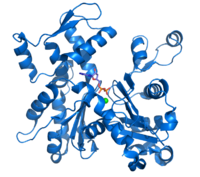
Photo from wikipedia
Homeostasis in skeletal muscle is sustained by the balance of functional and physical interactions between muscle and myofibre microenvironment. Various factors, such as ageing, disuse and denervation, tip the balance… Click to show full abstract
Homeostasis in skeletal muscle is sustained by the balance of functional and physical interactions between muscle and myofibre microenvironment. Various factors, such as ageing, disuse and denervation, tip the balance and induce skeletal muscle atrophy. Skeletal muscle atrophy, which involves complex physiological and biochemical changes, is accompanied by adverse outcomes and even increased mortality. Multiple studies have investigated the role of neutrophils in atrophied skeletal muscles; however, neutrophil intrusion in muscle is still a polemical knot. As technical obstacles have been overcome, people have gradually discovered new functions of neutrophils. The classical view of neutrophils is no longer applicable to their biological characteristics. To date, no clear association between the hidden injurious effect of neutrophil intrusion and muscle atrophy has been convincingly proven. Throughout this review, we have discussed the neutrophil activities that mediate muscle atrophy for distinct disease occurrences. Hopefully, this review will help both clinicians and researchers of skeletal muscle atrophy with relevant targets to further explore efficient medical interventions and treatments.
Journal Title: Journal of Cellular and Molecular Medicine
Year Published: 2022
Link to full text (if available)
Share on Social Media: Sign Up to like & get
recommendations!